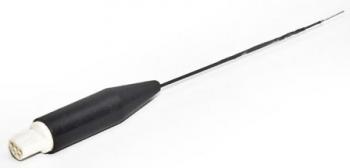ISO-H2S Hydrogen Sulfide Sensors
The WPI hydrogen sulfide sensor is highly selective and sensitive to H2S with a fast response time.
- Overview
- Specifications
- References
- Links
Low detection limit sensors to record in vitro.
Key Features
- Strong hydrogen sulfide selectivity and sensitivity with quick reaction
- Broad linearity
- For use with Apollo1000, Apollo4000, TBR4100 and TBR1025
- ISO-H2S-100-CXX requires cable 91580 (sold separate)
Options
- ISO-H2S-2 - 2 mm
- ISO-H2S-100-CXX - 100 μm
Benefits
- An equivalent-functioning dry sensor to a 2mm wet sensor
- Response Time: ~5 s
- Detection Limit: < 5 nM
- Sensitivity: 1-4 pA/nM
Applications
- Detect biological hydrogen sulfide in tissues or biological media in vivo or in vitro.
- Measure the hydrogen sulfide that medications release.
- Arteries, cell suspensions, cell culture, and in vivo applications
About Hydrogen Sulfide
Despite the fact that hydrogen sulfide is typically thought of as a deadly gas, many mammalian organs naturally produce it. In blood and brain tissue, it has been found in micromolar concentrations. Although its ability to participate in cell signaling is obvious, hydrogen sulfide is said to have a wide range of biological roles. However, its biological role is not fully understood. Because they share a number of physical and physiological characteristics, hydrogen sulfide and nitric oxide are strongly analogous.
Hydrogen Sulfide and Oxygen
Similar to nitric oxide, hydrogen sulfide is a powerful vascular signal that, depending on the tissue and oxygen concentration, can mediate either vasoconstriction or vasorelaxation. Hydrogen sulfide concentrations that elicit rapid constriction at oxygen levels in the rat aorta also cause quick relaxation at lower oxygen concentrations.
Sensor Details
A hydrogen sulfide sensor with a 100 µm tip diameter is called the ISO-H2S-100. It has a similar construction to dry microsensors, yet it performs similarly to a conventional 2 mm sensor. The sensor is available in a range of lengths, from 2 to 5 mm. It uses WPI's unique combination electrode technology, in which a single shielded sensor design houses both a hydrogen sulfide-sensing element and a separate reference electrode.
The ISO-H2S-100 has the following benefits:
- No sleeves or filling solutions are necessary.
- Due to the usage of platinum wire during production, this item is long-lasting
- Quick reaction time
- Extensive linear range (Range is determined by the sensor's tip's length)
The instrument was used in these investigations:
- Delivery of Hydrogen Sulfide by Ultrasound Targeted Microbubble Destruction Attenuates Myocardial Ischemia-reperfusion Injury.
Chen, G., Yang, L., Zhong, L., Kutty, S., Wang, Y., Cui, K., ??¦ Fang, J.
(2016). Scientific Reports, 6, 30643. - Hydrogen Sulfide Inhibits High-Salt Diet-Induced Renal Oxidative Stress and Kidney Injury in Dahl Rats.
Huang, P., Shen, Z., Liu, J., Huang, Y., Chen, S., Yu, W., ??¦ Jin, H.
(2016). Oxidative Medicine and Cellular Longevity, 2016, 2807490. - SIRT3 Mediates the Antioxidant Effect of Hydrogen Sulfide in Endothelial Cells.
Xie, L., Feng, H., Li, S., Meng, G., Liu, S., Tang, X., ??¦ Ji, Y.
(2016). Antioxidants & Redox Signaling, 24(6), 329??“343.
You can also visit site of the manufacturer.


